
Lunenburg is a port town on the South Shore of Nova Scotia, Canada. Founded in 1753, the town was one of the first British attempts to settle Protestants in Nova Scotia.
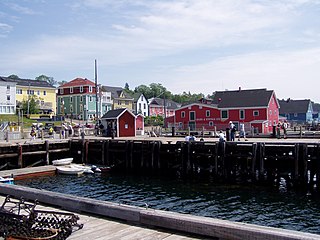
Lunenburg County is a historical county and census division on the South Shore of the Canadian province of Nova Scotia. Major settlements include Bridgewater, Lunenburg, and Mahone Bay.

Bridgewater is a town in Lunenburg County, Nova Scotia, Canada, at the navigable limit of the LaHave River. With a 2021 population of 8,790, Bridgewater is the largest town in the South Shore region.

Mahone Bay is a town on the northwest shore of Mahone Bay along the South Shore of Nova Scotia in Lunenburg County. A long-standing picturesque tourism destination, the town has recently enjoyed a growing reputation as a haven for entrepreneurs and business startups. The town has the fastest growing population of any municipality in Nova Scotia according to the 2016 census, experiencing 9.9% population growth.

The Expulsion of the Acadians, also known as the Great Upheaval, the Great Expulsion, the Great Deportation, and the Deportation of the Acadians, was the forced removal, by the British, of inhabitants of parts of a Canadian-American region historically known as Acadia, between 1755–1764. The area included the present-day Canadian Maritime provinces of Nova Scotia, New Brunswick, and Prince Edward Island, and the present-day U.S. state of Maine. The Expulsion, which caused the deaths of thousands of people, occurred during the French and Indian War and was part of the British military campaign against New France.
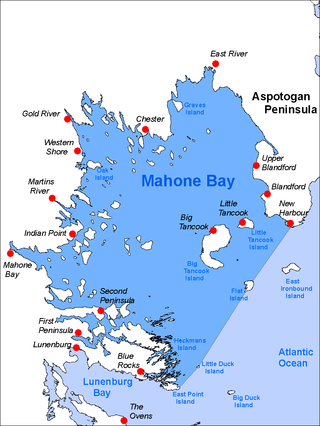
Mahone Bay is a bay on the Atlantic coast of Nova Scotia, Canada along the eastern end of Lunenburg County. The bay has many islands, and is a popular sailing area. Since 2003 the Mahone Islands Conservation Association has been working to protect the natural environment of the bay. The bay and its islands contain a variety of habitats including forests, rocky shores, beaches, wetlands, and mudflats. Wildlife in the area include black guillemots, eagles, osprey, leach's storm petrels, puffins, razorbills, and great blue herons.
The Aspotogan Peninsula is a peninsula in the eastern part of Lunenburg County, Nova Scotia, separating St. Margarets Bay in the east from Mahone Bay in the west. The peninsula was originally settled by second generation French immigrants on the east side and by second generation German immigrants on the west side. Traditionally fishing was a major industry for communities throughout the peninsula, however other primary industries such as farming and forestry were historically important as well. Shipping and shipbuilding were secondary and tertiary industries that also came into prominence during the 19th and early 20th centuries.

Dettlieb Christopher Jessen was one of the founding fathers of Lunenburg, Nova Scotia, and helped the village through Father Le Loutre's War, the French and Indian War and the American Revolution. He was German born. After his emigration to Canada, he became a militia leader, judge, and politician in Nova Scotia. His first name also appears as "Detleff". He represented Lunenburg County in the Nova Scotia House of Assembly from 1785 to 1793.
Mill Cove is a community in the Canadian province of Nova Scotia, located in the Chester Municipal District on the Aspotogan Peninsula on the Lighthouse Route. The community was home to CFS Mill Cove from 1967 til the 1990s.
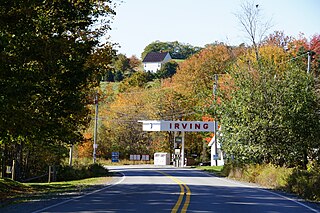
Newcombville is a community in the Canadian province of Nova Scotia, located in the Lunenburg Municipal District in Lunenburg County 11 kilometers or seven miles from Bridgewater-the county service center on the shores of the LaHave River.
Blockhouse is a community in the Canadian province of Nova Scotia, located in the Lunenburg Municipal District in Lunenburg County. It was named after the blockhouses constructed by Captain Ephraim Cook to protect colonists following a raid in 1756. The final blockhouse in the community burned down in 1874.
Conquerall Mills is a community in the Canadian province of Nova Scotia, located in the Lunenburg Municipal District in Lunenburg County near Bridgewater and Conquerall Bank which are located on the shore of LaHave River. Conquerall Mills is dominated by Fancy Lake which is the source for the picturesque Petite Rivière. Fancy Lake is home to small mouth bass and the invasive species of chain pickerel. There are warnings against fishing the endangered Atlantic White fish which are rumoured to exist in the Fancy Lake/Petite Rivière system. The community is 125 kilometers southwest of Halifax.
Second Peninsula is a community in the Canadian province of Nova Scotia, located in the Lunenburg Municipal District in Lunenburg County.

The Raid on Lunenburg occurred during the French and Indian War when Mi'kmaq and Maliseet fighters attacked a British settlement at Lunenburg, Nova Scotia on May 8, 1756. The native militia raided two islands on the northern outskirts of the fortified Township of Lunenburg, Rous Island, and Payzant Island. According to French reports, the Raiding party killed twenty settlers and took five prisoners. This raid was the first of nine the Natives and Acadians would conduct against the peninsula over a three-year period during the war. The Wabanaki Confederacy took John Payzant and Lewis Payzant prisoner, both of whom left written account of their experiences.

The Foreign Protestants were a group of French Lutheran and German Protestant immigrants to Nova Scotia. They largely settled in Halifax at Gottingen Street and Dutch Village Road as well as Lunenburg.

Nova Scotia is a Canadian province located in Canada's Maritimes. The region was initially occupied by Mi'kmaq. The colonial history of Nova Scotia includes the present-day Canadian Maritime provinces and the northern part of Maine, all of which were at one time part of Nova Scotia. In 1763 Cape Breton Island and St. John's Island became part of Nova Scotia. In 1769, St. John's Island became a separate colony. Nova Scotia included present-day New Brunswick until that province was established in 1784. During the first 150 years of European settlement, the colony was primarily made up of Catholic Acadians, Maliseet and Mi'kmaq. During the latter seventy-five years of this time period, there were six colonial wars that took place in Nova Scotia. After agreeing to several peace treaties, this long period of warfare ended with the Halifax Treaties (1761) and two years later when the British defeated the French in North America (1763). During these wars, Acadians, Mi'kmaq and Maliseet from the region fought to protect the border of Acadia from New England. They fought the war on two fronts: the southern border of Acadia, which New France defined as the Kennebec River in southern Maine. The other front was in Nova Scotia and involved preventing New Englanders from taking the capital of Acadia, Port Royal, establishing themselves at Canso.
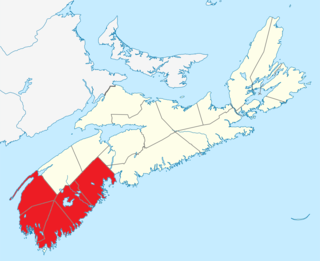
Southern Nova Scotia or the South Shore is a region of Nova Scotia, Canada. The area has no formal identity and is variously defined by geographic, county and other political boundaries. Statistics Canada, defines Southern Nova Scotia as an economic region, composed of Lunenburg County, Queens County, Shelburne County, Yarmouth County, and Digby County. According to Statistics Canada, the region had the highest decrease of population in Canada from 2009 to 2010, with a population decrease of 10.2 residents per thousand. The region also has the second-highest median age in Canada at 47.1 years old.

The Lunenburg campaign was executed by the Mi'kmaq militia and Acadian militia against the Foreign Protestants who the British had settled on the Lunenburg Peninsula during the French and Indian War. The British deployed Joseph Gorham and his Rangers along with Captain Rudolf Faesch and regular troops of the 60th Regiment of Foot to defend Lunenburg. The campaign was so successful, by November 1758, the members of the House of Assembly for Lunenburg stated "they received no benefit from His Majesty's Troops or Rangers" and required more protection.

The Zion Evangelical Lutheran Church is a church in Lunenburg, Nova Scotia. The church is the home of the oldest active Lutheran congregation in Canada. German Lutheran settlers arrived in 1753 and held services in the open air and later at St. John's Anglican Church (Lunenburg). The first church on this site was built in 1772 in preparation for the arrival of its first pastor, the Rev. Mr. Friederich Schultz at Lunenburg. He stayed for 8 years.
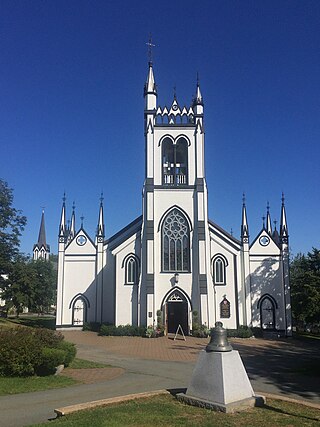
St. John's Anglican Church was the first church established in Lunenburg, Nova Scotia, Canada (1753). It is the second Church of England built in Nova Scotia, and is the second oldest continuous Protestant church in present-day Canada. Early on 1 November 2001, St. John's church suffered significant damage by fire. It was restored and re-dedicated June 12, 2005.















